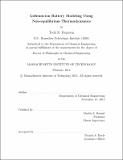| dc.contributor.advisor | Martin Z. Bazant. | en_US |
| dc.contributor.author | Ferguson, Todd R. (Todd Richard) | en_US |
| dc.contributor.other | Massachusetts Institute of Technology. Department of Chemical Engineering. | en_US |
| dc.date.accessioned | 2014-05-23T17:14:13Z | |
| dc.date.available | 2014-05-23T17:14:13Z | |
| dc.date.copyright | 2014 | en_US |
| dc.date.issued | 2014 | en_US |
| dc.identifier.uri | http://hdl.handle.net/1721.1/87133 | |
| dc.description | Thesis: Ph. D., Massachusetts Institute of Technology, Department of Chemical Engineering, 2014. | en_US |
| dc.description | This electronic version was submitted by the student author. The certified thesis is available in the Institute Archives and Special Collections. | en_US |
| dc.description | Cataloged from student-submitted PDF version of thesis. | en_US |
| dc.description | Includes bibliographical references (pages 147-161). | en_US |
| dc.description.abstract | The focus of this thesis work is the application of non-equilibrium thermodynamics in lithium-ion battery modeling. As the demand for higher power and longer lasting batteries increases, the search for materials suitable for this task continues. Traditional battery modeling uses dilute solution kinetics and a fit form of the open circuit potential to model the discharge. This work expands on this original set of equations to include concentrated solution kinetics as well as thermodynamics-based modeling of the open circuit potential. This modification is advantageous because it does not require the cell to be built in order to be modeled. Additionally, this modification also allows phase separating materials to be modeled directly using phase field models. This is especially useful for materials such as lithium iron phosphate and graphite, which are currently modeled using a fit open circuit potential and an artificial phase boundary (in the case of lithium iron phosphate). This thesis work begins with a derivation of concentrated solution theory, beginning with a general reaction rate framework and transition state theory. This derivation includes an overview of the thermodynamic definitions used in this thesis. After the derivation, transport and conduction in porous media are considered. Effective transport properties for porous media are presented using various applicable models. Combining concentrated solution theory, mass conservation, charge conservation, and effective porous media properties, the modified porous electrode theory equations are derived. This framework includes equations to model mass and charge conservation in the electrolyte, mass conservation in the solid intercalation particles, and electron conservation in the conducting matrix. These mass and charge conservation equations are coupled to self-consistent models of the charge transfer reaction and the Nernst potential. The Nernst potential is formulated using the same thermodynamic expressions used in the mass conservation equation for the intercalation particles. The charge transfer reaction is also formulated using the same thermodynamic expressions, and is presented in a form similar to the Butler-Volmer equation, which determines the reaction rate based on the local overpotential. This self-consistent set of equations allows both homogeneous and phase separating intercalation materials to be modeled. After the derivation of the set of equations, the numerical methods used to solve the equations in this work are presented, including the finite volume method and solution methods for differential algebraic equations. Then, example simulations at constant current are provided for homogeneous and phase separating materials to demonstrate the effect of changing the solid diffusivity and discharge rate on the cell voltage. Other effects, such as coherency strain, are also presented to demonstrate their effect on the behavior of particles inside the cell (e.g. suppression of phase separation). After the example simulations, specific simulations for two phase separating materials are presented and compared to experiment. These simulations include slow discharge of a lithium iron phosphate cell at constant current, and electrolyte-limited discharge of a graphite cell at constant potential. These two simulations are shown to agree very well with experimental data. In the last part of this thesis, the most recent work is presented, which is based on modeling lithium iron phosphate particles including coherency strain and surface wetting. These results are qualitatively compared with experimental data. Finally, future work in this area is considered, along with a summary of the thesis. | en_US |
| dc.description.statementofresponsibility | by Todd R. Ferguson. | en_US |
| dc.format.extent | 161 pages | en_US |
| dc.language.iso | eng | en_US |
| dc.publisher | Massachusetts Institute of Technology | en_US |
| dc.rights | M.I.T. theses are protected by copyright. They may be viewed from this source for any purpose, but reproduction or distribution in any format is prohibited without written permission. See provided URL for inquiries about permission. | en_US |
| dc.rights.uri | http://dspace.mit.edu/handle/1721.1/7582 | en_US |
| dc.subject | Chemical Engineering. | en_US |
| dc.title | Lithium-ion battery modeling using non-equilibrium thermodynamics | en_US |
| dc.type | Thesis | en_US |
| dc.description.degree | Ph. D. | en_US |
| dc.contributor.department | Massachusetts Institute of Technology. Department of Chemical Engineering | |
| dc.identifier.oclc | 879680220 | en_US |
